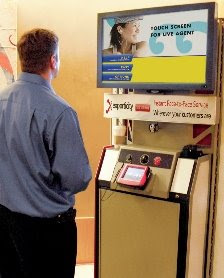End of Human Help in Stores
 July 18 (MSNBC - Bob Sullivan) Imagine standing in a retail store desperately looking for help from someone, anyone, and being directed to … a computer screen. This just might be the future of customer service. Two companies, with products named Live Agent and Live Support, hope that consumers who today wander aimlessly through store aisles looking for help would be happy to use videoconference kiosks instead.
July 18 (MSNBC - Bob Sullivan) Imagine standing in a retail store desperately looking for help from someone, anyone, and being directed to … a computer screen. This just might be the future of customer service. Two companies, with products named Live Agent and Live Support, hope that consumers who today wander aimlessly through store aisles looking for help would be happy to use videoconference kiosks instead.Already, shoppers in 34 Canadian Staples Business Depot stores all around the country have the option of getting video help from operators based in Toronto, according to Seattle-based Experticity, which makes the video kiosks for Staples.
Stores that are strapped for cash and have trouble hiring knowledgeable employees can offer better customer service through videoconference kiosks, says Chris Woods, chief technology officer of ClairVista, which makes Live Expert. Companies can also save money by leaning on a centralized staff, he said. “Everybody who goes into a retail store today and walks away frustrated that they could not get their questions answered can get the help they need,” Woods says.
But won't customers lean on the exit doors after realizing the store has no plans to provide live human beings to help? DL Baron, CEO of Experticity, says just the opposite has occurred in trials at Staples. "We found that consumers are lining up to talk to the person on the screen because they know the dopey kid behind the counter can't answer their question," he said. "When consumers start using it, it becomes their preferred mode of engagement."
Long-distance, video-based help has a number of obstacles to overcome, both companies concede. Chief among them is the impression consumers might get that the machines are there simply to replace humans and cut costs. If companies can't even bother to greet store shoppers with in-person smiles, why would consumers bother to go to the store?
Baron counters that consumer help in many large retailers is already poor, and long-distance help will actually be an improvement. "How many times have you walked out of the store because you knew more than the kid who was helping you?" he said. Floor clerks have an impossible task in trying to "keep up with and explain increasingly complex products." With a centralized set of agents, each one can specialize in a product area and provide better advice. Agents can also use interactive screens to show consumers how to complete challenging tasks such as electronics installations, and even print out instructions for consumers, Baron said. Buyers with Web cams can connect to customer service again from home for additional help.
That's assuming the video conference technology works, of course. Web cams are notoriously flaky, as anyone who's tried home video-conference tools can attest. And of course, the advice will only be as good as the operators who are hired to give it. A home improvement store might convince fantastic kitchen remodeling experts to answer video questions 24 hours per day. But it's easy to imagine a firm hiring ill-equipped $8-an-hour operators to read off poorly written scripts instead.
Customer service expert Robert Spector, author of "The Nordstrom Way," said companies should tread carefully when making fundamental changes to the way they treat in-store shoppers. "A lot of (companies) get enamored with the technology and lose site of the consumer," he said. "Many companies don't think like their customers, they think in ways to make (the company's) life easier, rather than ‘how do we make the consumer’s life easier.’ "
Replacing real customer service with discount gimmickry never works, he said. In one personal pet peeve, Spector said he's had several frustrating run-ins with live chat supports offered by Web sites. "I always feel like I could do much better actually talking to someone than just comparing typing skills," he said. Live video help could work he said, but only if it’s nothing like live chat help.
But even if the videoconference service tools aren't perfect, and the customer service benefits are dubious, remote assistance may be attractive to major retailers because of the potential cost savings. Home improvement stores face a crush of ambitious project builders every Saturday morning, but by 2 p.m., the panic has died down and many highly skilled employees are stuck stocking shelves, Baron said. If stores could "load balance" customer support by funneling all questions through a central support team, they could keep top employees occupied with higher-skill tasks. Woods argues that centralized video service would both cut costs and make customers happier. "If you could take the top 50 associates you have and take them off the sales floor and make them available chain wide, that's the ideal situation," Woods said.
In Baron’s perfect world, there’s a customer service video screen at the end of every store aisle, with a top-tier expert ready and willing to answer your question. What’s the worst-case scenario? Think about toll-free hotlines. When was the last time you preferred waiting on hold and talking to someone half-way around the world to getting help in person?


Comments